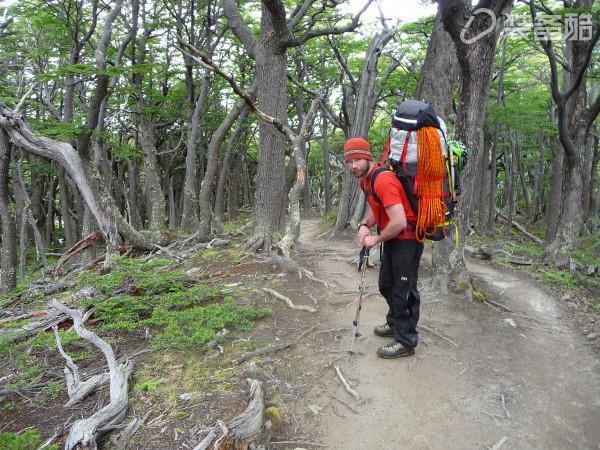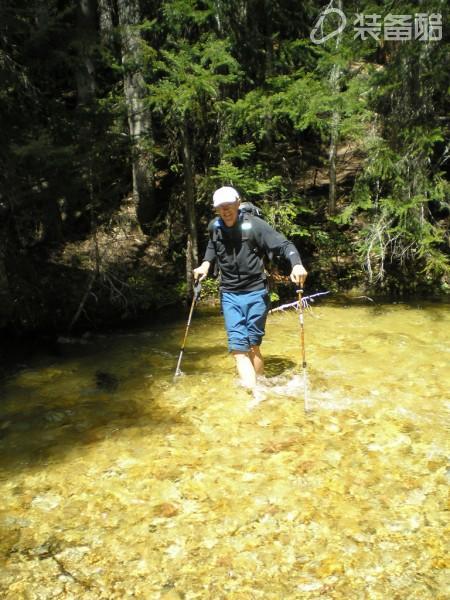Almost no one used a trekking pole 10 years ago. Now it is rare to see ALICEs not use it on foot when reloading, and many light trekkers also use them. Trekking poles can help you balance on rugged roads and save energy on steep mountain paths. Some studies have shown that trekking poles can reduce the impact of 40% on the knee, which is useful for backpackers or hikers of all ages.
First of all, if you are thinking about: "Why do I need a trekking pole when trekking?", you can look at our article: "10 Reasons to Use Trekking Poles."

Trekking poles helped Ian Nicholson carry 75 pounds/34 kilograms into the French Valley in the Torres Del Paine National Park in Patagonia.
Photo credit: Graham Zimmerman
Here are the issues to consider when purchasing trekking poles:
The trekking pole adjustment mechanism: The trekking pole of the external locking structure is generally easier to adjust than the internal locking structure.
Number of knots: The trekking poles in the two sections are stronger and harder, suitable for skiing or those who use extreme pressure on the rods. The trekking poles in the three sections are more compact and strong, and they are currently the most purchased styles for hiking, crossing, outdoor, climbing and climbing.
Material: Aluminum and carbon fiber are the two most used materials for trekking poles. Carbon fibers are lighter, harder, and usually stronger, but if they are hit by impact they leave the pits and they play. In contrast, aluminum sticks are a bit heavy, but one or two holes do not affect use.
Blocking board size: Selecting the size of the trekking pole arrester depends mainly on what activities you plan to carry out. Most trekking pole manufacturers use holes of different diameters so that the trapping plates cannot be universal, but some manufacturers can interchange them. When you want to buy a new trap board, go with the trekking poles to the store to see if they are suitable, or other brands of trap boards can hold your trekking poles. Larger traps are suitable for snow sports, but are easily caught by roots or shrubs as you cross the trees. Some companies make 3/4 size traps, but you can think of this as a compromise product.
Absorb shock: Is this a trick? Some people say this is useful. None of our testers felt that the cushioning function made the trekking poles more comfortable. The cushioning function makes the trekking pole feel a bit unstable, especially when passing through the torrent on the rock, or when more trekking poles are needed to support balance.

Amos Galpin uses trekking poles in common terrain in Cascade
Photo credit: Ian Nicholson
Weight: Of course the lighter weight of the rod is better. However, the difference between trekking poles is not as obvious as other large items such as backpacks and tents. For example, the difference between the heaviest trekking poles we tested and the lightest was 8 ounces (227 grams). This may not seem like much, but when you wave it up and down thousands of times a day, it may be a huge burden if you have to travel 10,000 or more times on a long journey. Those donkeys who do not like trekking poles are often more likely to be moved by lighter trekking poles.
Handle: There are many types of handles. The rubber handles do not absorb water, making them more suitable for hiking, snow hikes, skiing and other winter sports. The foam handle is softer and the friction is smaller (yes, some donkeys with rubber handles are rubbed with blisters or palms rubbing against the heat), keeping your hands so hot. Cork is the favorite of most people, and they work together to the same extent as Birkenstock. (Note: Birkenstock, a shoe brand known for its comfort.)
Folding: This is very important for some donkeys. Climbers, climbers and some backpackers need the ability to hang a trekking pole in a backpack or put in a backpack. The trekking pole is as short as possible. Another advantage of shorter trekking poles is that it is more convenient to travel.
Versatile: Multipurpose refers to what you can do with your trekking pole, or what you are good at. We compared these trekking poles, and in each separate test report, we talked about the different uses of each trekking pole for walking, outdoor, crossing, rock climbing, climbing, skiing, snow walking, and detachable snowboarding. The general view is that when you participate in sports that require a trekking pole, such as rock climbing or detachable skis, the trekking pole is as small as possible. The trekking poles with shock absorption function are suitable for difficult dirt roads, but they are not suitable for rocky areas or crossing routes that require balance ability. Because the shock affects the sense of balance, the trekking pole becomes useless and adds weight in vain.
Experience: In order to make your trekking poles last longer, remove your trekking poles and dry them after each use, especially in wet or snow conditions.
Translator: å·å³¨ å·å³¨ å±±
Original Title: How to Choose the Best Trekking Pole
Original author: Chris McNamara
Original source: outdoorgearlab.com
Special statement: This article is derived from the original author, copyrighted works belong to the original author and their media! If you think we have infringed your copyright, please let me know! This site is immediately deleted
Hand Puppet,Soft Hand Puppet,Black Bear Hand Puppet,Squirrel Finger Hand Puppet
Guangdong Hayidai Toys Co., LTD. , http://www.hayidaiusa.com